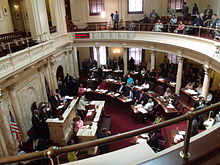New Jersey Senate
| New Jersey Senate | |
|---|---|
| New Jersey Legislature | |
 |
|
| Type | |
| Type | |
|
Term limits
|
None |
| History | |
|
New session started
|
January 14, 2014 |
| Leadership | |
|
Deputy Majority Leader
|
|
| Structure | |
| Seats | 40 |
 |
|
|
Political groups
|
Governing Party
Opposition Party
|
|
Length of term
|
2 or 4 years |
| Authority | Article IV, New Jersey Constitution |
| Salary | $49,000/year |
| Elections | |
|
Last election
|
November 5, 2013 (40 seats) |
|
Next election
|
November 7, 2017 (40 seats) |
| Redistricting | New Jersey Apportionment Commission |
| Meeting place | |
 |
|
| State Senate Chamber New Jersey State House Trenton, New Jersey |
|
| Website | |
| New Jersey State Legislature | |
Governing Party
Opposition Party
The New Jersey Senate was established as the upper house of the New Jersey Legislature by the Constitution of 1844, replacing the Legislative Council. From 1844 until 1965 New Jersey's counties elected one Senator, each. Under the 1844 Constitution the term of office was three years. The 1947 Constitution changed the term to four years. Since 1968 it has consisted of 40 Senators, who are elected in a "2-4-4" cycle, representing districts with average populations of 210,359 (2000 figures). The "2-4-4" cycle was put into place so that Senate elections can reflect the changes made to the district boundaries on the basis of the decennial United States Census. (If the cycle were not put into place, then the boundaries would sometimes be four years out of date before being used for Senate elections. Rather, with the varied term, the boundaries are only two years out of date). Thus elections for Senate seats take place in years ending with a "1", "3" or "7" (i.e. next elections in 2017, 2021 and 2023).
Interim appointments are made to fill vacant legislative seats by the county committee or committees of the party of the vacating person (since a constitutional amendment passed on November 8, 1988). The office is on the ballot for the next general election (even if the other Senate seats are not up for election in that year, such as in years ending with a "5" or "9", such as 2009 or 2015), unless the vacancy occurred within 51 days of the election. Then the appointment stands until the following general election.
Senatorial courtesy is a Senate tradition that allows home county legislators to intercede to prevent consideration of a local resident nominated by the Governor for a position that requires Senate confirmation. Any of the senators from the nominee's home county can invoke senatorial courtesy to block a nomination, temporarily or permanently, without any obligation to justify the basis of their actions.
Governor Corzine nominated Stuart Rabner on June 4, 2007, to be the next Chief Justice of the New Jersey Supreme Court, replacing James R. Zazzali, who was nearing mandatory retirement age. Shortly after the nomination, two members of the Senate from Essex County, where Rabner resides, blocked consideration of his confirmation by invoking senatorial courtesy. State Senator Ronald Rice had initially blocked the nomination, but relented on June 15, 2007, after a meeting with the governor.Nia Gill dropped her block on June 19, 2007, but did not explain the nature of her concerns, though anonymous lawmakers cited in The New York Times indicated that the objection was due to Rabner's race and Governor Corzine's failure to consider a minority candidate for the post.
...
Wikipedia
